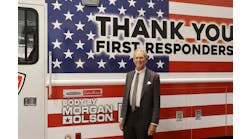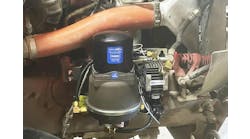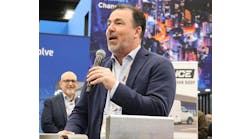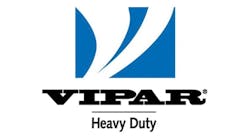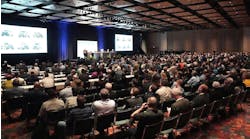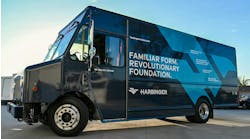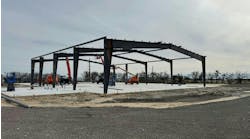Everyone along the supply chain, from supplier and OEM, to wholesaler and distributor, agreed on one thing—2018 was a strong year for players in every corner of the truck and trailer industry.
But that success also came with new questions and concerns for the future.
This is where participants in a Heavy Duty Aftermarket Dialogue panel addressing changes in distribution sometimes differed, depending on their priorities and place in the chain, on topics ranging from expectations to worker shortages, diversity in the workplace, and the impact of e-commerce on traditional business models.
The question-and-answer session included Mike Harris, senior vice president of sales and branch operations for truck and trailer parts distributor FleetPride; Stefan Kurschner, senior VP of aftermarket for OEM Daimler Trucks North America (DTNA); Carl Mesker, VP of sales for commercial vehicle supplier SAF Holland; and Walt Sherbourne, VP of marketing for wholesaler Dayton Parts.
Selected questions and answers are edited for length and clarity.
Has the success of last year carried over to 2019, and if so, what are your thoughts, expectations or goals for your businesses moving forward?
Harris: “For FleetPride, it’s finishing a strong year, like all my counterparts here. I’ve also heard … in conversations with a number of suppliers, other distributors and OEMs, that it sounds like everyone is experiencing a strong start to 2019, and certainly we’re seeing that through January. And so I’d say, for 2019, our outlook is positive. We’re optimistic, certainly through the first half of the year. Obviously, the order boards are filled and backlogged through the end of the year. Those are all good indicators. But for us, like many others, it’s trying to understand better what the second half of 2019 could look like. So we’re plugging those scenarios into our financial models, trying to make sure we understand what that could be, and that we’re prepared for whatever might come.”
Kurschner: “2019 started how 2018 ended—very strong. I think that will continue for the first half, and … then we’re going to see some level of normalization from being a strong market. We’ve got to look for early warning indicators. Cancellation was mentioned already. This is definitely something we’re going to look out for, and whatever other early-warning indicators we can see.”
Sherbourne: “It was a strong first month … but a month doesn’t make a trend. We’ve got challenges coming ahead. We don’t know what’s going to happen with tariffs. We don’t know a few other things in the economy. So I don’t think we’re going to see a cliff event, but maybe a slowdown, to Kurschner’s point of watching those indicators.”
Carl, in regard to capacity, you had such a successful year last year, you just couldn’t build some parts fast enough. Is that the biggest challenge in 2019 for your company, or are there other challenges or tasks out there you really need to figure out how to handle in the next couple months?
Mesker: “We’ve already ramped up all of our production to be at the rate it needs to be at, and then some, because we had to give ourselves some cushion. If anybody’s run a plant before, you never plan on running at 100% capacity, which is a recipe for disaster. You always plan on 95%. That’s about the right spot. So we’ve already over-ramped to keep up with supply, so we have a little bit of cushion where we’re taking care of our past dues and getting things caught up. So for 2019, the first part, I’m not nearly as concerned as I was in the first part of ’18. Now the concern is slowly becoming, keeping my eyes open for when it trails off, because we need such a long lead time. If we wait until the cancellations come, it’s already too late. The material’s already on its way to us. So from our side it’s now become a watching game of what indicators are going to trigger this slowdown—if it comes in this year. It may not come in ’19 at all.”
Stefan, is it the same situation for you guys at Daimler? Or are there other top-tier challenges that need to be addressed first?
Kurschner: “Ramping up was the problem last year, but everybody has caught up, to a certain extent. Yes, there is always one thing that is missing, clearly, but no, we are now in a position where everybody has adapted to the demand, which showed itself in the latter part of 2018. And based on this level, everybody’s leveling in, and pretty happy. I can only agree that running a plant at 100% is a difficult thing to do, but everybody has adjusted, and now it’s about optimizing.”
Sherbourne: “We can get the product out the door. … Our biggest challenge is people. The younger generation doesn’t want to work in a manufacturing plant. So the hiring, the talent, with the low unemployment rates we’ve had this past year and a half, just trying to find a qualified person, we’re getting down to people who don’t want to work. They may want to work one day but they don’t want to come in the second day. So that’s a big challenge.”
For the manufacturers on the panel, and suppliers, what can you do to train your distributors, so they have as much information as possible at their disposal, and can bring people into the business who have the information necessary to successfully sell your product?
Sherbourne: “One of the biggest things we’re doing is getting our sales people trained well enough to feel confident going out there and training the counter guys and sales guys, the outside sales people. So we’re not only doing training seminars within our own company, to get them trained, we’re also taking those outside and going to the independent distributor base, and dealer base as well, for those guys who are direct with us.”
Mesker: “Our sales team’s out training as well. But I don’t think we can do it the way we’ve done it in the past. Yes, we still have guys going into the counters, and training the counter guys, and talking to them, but also going down a path of learning management systems, so guys can log on and learn at their own pace online. But ultimately I’d like to get to a point where we serve our people completely online, to not only be able to look up and identify our product, but our competitors’ as well. If they’re going to be trained in one of the product lines, it needs to be the whole product line and not just ours. For a counter man, that’s really critical. It doesn’t help him just to know one brand. He’s got to know them all.”
Kurschner: “Our products are becoming more and more complex, so everybody is involved in training our customers, and we’re doing what we can to provide training and use the new technology. But one thing that is very important for the industry overall is to attract talent. Trucking will keep America moving. Everything we sit on has been moved by a truck, so you can build a good career working somewhere within the trucking industry. And it’s a task for everybody to make this industry attractive for talent to join, from a mechanic to all the jobs they have to offer, and working at a parts counter is a good career, too. There is a future in it.”
Sherbourne: “We’ve also gone down to the community colleges, the college’s locally in Harrisburg (PA), to at least introduce the industry to the students who are not really decided on where they want to go yet, showing them all there is in our industry, from a guy manufacturing in a plant all the way up to engineering and accounting, and getting them accustomed to our industry.”
One thing we consistently hear in this industry is, parts need to be there immediately—uptime, uptime, uptime. What are you doing within your distribution channels to make sure you can get parts to the customer, same day, next day, and get that truck on the road as quickly as possible?
Harris: “A lot of attention has been paid, and certainly investments made, this past year, with a lot of capex dollars shifting toward the supply chain, and in our business we have five distribution centers, and so we constantly evaluate, ‘Do we have enough distribution centers, are they the right footprint, are they in the right spots?’ and ultimately part of what we’ve done on the supply chain is take on the task of replenishing the inventory much faster to the stores, to the branches around the country. We have just over 270 branches, and today over half of those get five-day-a-week replenishment from a regional distribution center. And certainly that’s not a cheap endeavor, but one that is needed in the independent channel to keep up the pace with the large OEMs, and the larger OEM distribution channels, who widely already have that in place, or more. And so for us, the ultimate goal is to allow our counter people, or salesperson in a local market, if they need access to parts beyond what’s in the store, to be able to push a button at 5 pm, and that part be there the next day at 8 am. That’s our vision. We’re well on our way there, but still have quite a way to go.”
Stefan, you guys have added distribution centers the last couple years. How did you determine exactly where those needed to be to maximize your same-day, next-day shipping?
Kurschner: “Nobody buys parts in our industry because they like to buy parts. They buy because they have to buy parts. And so it starts with what our customers need. And uptime, or avoiding downtime, is the name of the game. We said we’re going to make the commitment to our customers to turn around the truck in 24 hours or less. So everything is structured around fulfilling this goal. Setting up our distribution network infrastructure is built on, ‘Okay, here are our trucks, here are our customers, here are our service points, how do we get the parts to those points in 24 hours or less?’ I don’t want to share a whole lot more insight about how we get there, but clearly it’s always triggered by the goal of making the downtime event as short as possible.”
Mesker: “We look at this twofold. One is the one unit-down situation, and how we support the distributors on unit downs. Previously, we didn’t find out about a unit down until after it already went through the distributor’s gates … so the intensity and awareness of unit downs has increased exponentially. Every morning I get an email report that tells me exactly how many trucks are down in the US, waiting for parts from us. Supporting the distribution base with the products and inventory they need is the secondary part of it. We’ve got to make sure the channel is full. That was a struggle in all of 2018. And we are also looking at, do we have the right distribution points? And then with the product we have, in those distribution points, as a tier-one manufacturer we have to have the courage to end the product’s life. When we have obsolete suspensions from 1973, we have to stop selling parts for those.”
Sherbourne: “We’ve worked very closely with a lot of our strategic transportation companies to make sure they’re picking up at a certain time and delivering overnight. So we’re taking on the whole supply-chain infrastructure. We’ve also had a lot of people with UPS and FedEx shipments. So the demand I see, for those types of shipments, has gone up. Stock orders are dwindling a little bit, and the ‘I need it now’ has gone up.”
How are you handling the growth of e-commerce platforms in your market? What can you do to help your distributors either sell on e-commerce, or better position themselves to compete against anyone?
Mesker: “It has taken a lot of time and energy from everyone in the industry. As an industry, we’ve seen the e-commerce, we’ve seen the technology, and it’s almost like we came to the top of the hill and we’re looking at this valley, with all this new stuff—telematics, driver-aid controls and all of this technology linking together—and it’s almost paralysis by analysis. There’s so much stuff to look at you can’t focus. But e-commerce is definitely here. We learned from the MacKay & Company internet study about 17% of people placed their orders online in 2017. So that tells us there’s at least that percentage of people who want to buy online, and the projection is, it’s going as high as 30% in the future. So, as a supplier, we’re reinventing our e-commerce site, for about the third time, and every time we learn more, and what we’re learning are the things that distributors are going to learn when they launch theirs. We need to supply images, and we’re working on the database to do that, and a data management system. We know we have to adapt to an industry standard, because if you’re going to do this economically, and for many different values, there has to be a standard. It’s getting the tier-one suppliers to adopt these standards, so that e-commerce is viable for our distribution base to build in an economic way.”
Mike, are you getting what you need from your suppliers as it relates to Fleet Pride’s e-commerce capabilities?
Harris: “We are, and at a faster pace than we ever have before. Our supplier partners have certainly embraced the standards that Paul’s referencing. At the end of the day, it will benefit the entire value chain and certainly make it easier for our customers to identify what they need quicker and faster. And as Stefan noted earlier, vehicle uptime is important, and keeping that customer’s truck on the road is certainly at the center of all of those efforts. So the supply base has engaged it, to a certain extent, and we continue to see that ramping up, which will make for a better e-commerce platform for the entire industry.”
Kurschner: “The digital platform makes aftermarket a really interesting place to be, because it’s a way of connecting with customers we all have to adapt to. And everybody likes to research and buy on digital platforms, but we also have customers who still like their fax machines, so the aftermarket has to serve both sides of the equation. We are right now in a phase where we’re figuring out what a digital platform has to look like. There is a certain amount of standardization that needs to happen. In the first few years of the internet, there were websites we didn’t even understand when we got there. It took a while to get it standardized. So that will happen. But it’s definitely a way of interacting with our customers, it’s a way to make the transaction faster, and it will increase transparency.”
Starting with the manufacturer supply chain, how do you make sure you have a product line that can serve every potential customer in the aftermarket?
Sherbourne: “We go down to the product portfolio and determine what types of vehicles are out there, how many are out there, and how long they’ve been out there, so that at least we know if there is a product that fits a 1970s vehicle. On the manufacturing side, I could make a spring for a 1933 Ford. Do I keep it in stock? No. But can I have it readily available? Yes. So it’s there, it’s available, (and) … we do some of this e-commerce already. If you really think about it, and you look at it, we’re there. Our distributors’ customers are doing the research … they’re placing orders and we’re shipping it to get it there.”
Mesker: “Product availability is always a struggle, so as a supplier to the industry, we understand distributors absolutely can no longer stock an entire product line. The days of going in and saying, ‘Here’s your standard list of stuff you need to stock,’ are long gone. Every distributor and dealer must tailor their inventory to the fleets they serve. So then it becomes a challenge to make sure you have, somewhere available in your system, the products they’re going to need … that don’t move all the time. Those you have to be able to get your hands on, and that’s a responsibility for us as a supplier. This is why we have distributions we didn’t have 15 years ago, and are going to continue to increase those.
What is the impact of Amazon on the truck aftermarket? As they begin to take over customers’ entire procurement systems, the idea of Amazon being more customer-oriented is changing. How can the aftermarket compete?
Sherbourne: “Ultimately, today, that’s happening. Amazon’s selling my products and I don’t sell them direct. They’ve got it, they sell it, they have a different value proposition then the distribution base themselves. Nobody likes to say the word Amazon. I don’t care about Amazon. I buy on Amazon, but I know it’s not coming from Amazon. Until Amazon puts the inventory in the warehouse, on the truck side, instead of me fulfilling it or my distributor fulfilling that order, it’s still not coming directly from Amazon. So the distribution base is getting that win. The trouble that Amazon has is the return. If they make a wrong decision on a part, they ultimately call me, the supplier, and then I’ve got to figure out who sold it because I had nothing to do with that transaction. So from a distribution standpoint, it’s being done today. The other thing you’ve got is, they don’t have that expertise on the counter, which is that value proposition, or at the dealership counter, where they get the right part before they walk out. They may, because they do say this part fits this vehicle. So Amazon’s a scary word, everybody scared of it, but let’s not get hung up on it until they actually put parts in their warehouse, and they’re stocking the parts.”
Kurschner: “Amazon is an interesting company, and that’s all I’m going to say about Amazon. But there are things we can learn from them. They have a tremendous digital platform they have built, and they have a good way with how they treat their customers. But then again, it goes back to the customer makes the ultimate choice where and how to order. You have to be prepared for it, and if your customer decides to go somewhere else, you’re not fulfilling a need, and that’s the way to approach any business.”
Mesker: “If anything, we’ve learned something from them, and what we learned was to think about the parts transaction differently. There are some parts transactions that require consultative sales, where you need someone to help you pick the right brand, the right partner, or make sure it’s the right product for you. And there are some sales where you’ve got to have that part right when you buy it, and it’s got to be on someone’s shelf. So there are all different types of purchases. What Amazon did is found a niche where they can use their expertise in transactions and capitalize on it.”
Do any of your companies have initiatives around building more diverse teams or increasing diversity in your company?
Harris: “It’s important for us to make sure we’re reaching out and trying to tap into all of the opportunities out there that exist to fill the roles. We’re a growing company, and there’s a vacuum for talent, and so making sure we open up all of those channels is certainly something we’re focused on. It’s important that we fill the roles quickly—time is of the essence. We want to make sure we’ve got candidates coming in for all different types of roles, from all different areas, and we believe it’s going to take that, at least that, to fill the needs of the business as it moves forward.”
Kurschner: “It’s proven that diverse teams create the best results. That’s what diversity stands for. We’re looking for diversity that is part of our everyday business. Clearly, we emphasize it in the hiring process as well. We want to have the best possible diverse teams to solve problems, because if you get this diversity, you get the richness of ideas, which ultimately will lead to a solution.”
Mesker: “I couldn’t agree more. But defining what you need is more important than forcing that diversity. You can’t force it. You have to understand what you’re looking for, and a diverse team is exactly what you look for.”
RockAuto has destroyed margins in the light-vehicle space. Do you have concerns with this happening in the commercial vehicle market?
Harris: “It’s something to watch. But the trucking industry is different. The data within the automotive industry is much different than the data that gets exchanged in the heavy-duty industry. We all do that every day, and so it presents its challenges. But at the same time … you have to look at all the e-commerce tools out there and understand, how are you prepared as a business to meet those demands as the needs of the customer evolves. There are products they certainly may want to buy online, where it’s more convenient, in addition to your dealer network, or your independent distribution channel branches in the market. So we’ll look at it as more of an opportunity to learn from what’s going on out there, and make sure we’re prepared if those investments are needed to make sure we’re ready for what’s ahead.”
Sherbourne: “The buzzword I’ve heard, and I didn’t even know what this was until I looked it up, is omnichannel. Well, we do that today. Nobody really knows we do that. You look at the Lowe’s of the world, the Home Depots of the world—they’re learning from this e-commerce. They now have pick-up at the store. You can order it online, if you want to, in the middle of the night and pick up the next morning. Is that going to come to us? Probably in the near future it will, as we put more distribution centers up across the country, and get closer to that customer. And my customer is the end-user as well, but so is my distributor. But ultimately we’re focused on that end-user and how quickly we get that part to them, so if Mike has to order a part, he may order it in the middle of the night, and his customer goes and picks it up at our DC or his DC, or even the local the local distribution point. That may happen.”
